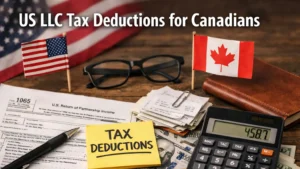The tax agreement between Canada and the United States is a detailed agreement that regulates how taxes are handled for individuals and companies who do business or earn money in both countries. This blog will help you understand how does the tax treaty work between Canada and the US better.
Connect SAL Accounting today to understand global taxes better. Get expert tips to improve your business’s tax strategy and stay ahead in the worldwide financial scene. Discover the ins and outs of tax treaties for a competitive edge
This agreement helps prevent people from being taxed twice, ensures fairness, and provides clear rules for residents and businesses in both places. The Canada-U.S. tax treaty was created in 1980 and covers various types of income, including:
- Earnings from employment
- Business profits
- Dividends
- Interest
- Royalties
- Sale of assets
Table of Contents
NEGOTIATION AND PURPOSE OF THE TAX TREATY WORK BETWEEN CANADA AND THE US
The agreement between Canada and the United States about taxes was made to help business activities that happen between the two countries, make trade and investing easier, and stop people and companies from being taxed twice.
They first agreed on this in 1980 and have changed it a bit since then. This agreement shows that both countries want to ensure everyone is taxed fairly when they do business across borders.
FUNDAMENTAL OF THE TAX TREATY
1. RESIDENCY RULES AND TIE-BREAKER PROVISIONS
The treaty outlines standards to identify where someone lives for tax purposes. It considers factors like their permanent home, important connections, regular residence, and nationality.
If someone is considered a resident in two places, there are rules to decide which place should tax them more. This prevents confusion and double taxation.
2. AVOIDING DOUBLE TAXATION
The main aim of the tax treaty work between Canada and the US is to prevent the same income from being taxed twice. It does this using methods like the foreign tax credit and the exemption method. With the foreign tax credit, someone can get a reduction in their own country’s taxes for the taxes they’ve already paid in the other country. The exemption method lets certain types of income avoid being taxed in one of the countries.
3. ALLOCATION OF TAXING RIGHTS
The tax treaty work between Canada and the US sets clear rules for deciding which country has the right to tax different types of income:
- Business Profits: If a business has a permanent place where it operates, that country can tax its profits. This avoids double taxation.
- Dividends, Interest, and Royalties: The treaty makes it easier for businesses to invest in each other’s countries by reducing the tax rates on the money they earn from dividends, interest, and royalties.
- Capital Gains: Making money from selling property, like real estate, is usually taxed in the country where the property is located. Other capital gains might be taxed where the person lives.
- Pensions and Social Security: The treaty ensures that pensions and social security payments are typically only taxed in the country where the recipient lives. This prevents double taxation of these important sources of income.
4. AMENDMENTS AND UPDATES
Tax agreements like this can change over time to match new economic conditions and tax standards. Regular reviews and changes make sure the treaty continues to work well in handling new challenges and opportunities in cross-border taxation.
5. SEEKING PROFESSIONAL GUIDANCE
Understanding the complexities of the Canada-US tax treaty is best done with the help of experts. People are advised to consult qualified professionals who specialize in international taxation. These experts can provide tailored advice, making sure they follow both countries’ tax laws while getting the most out of the treaty benefits.
HOW DOES THE TAX TREATY WORK BETWEEN CANADA AND THE US ?
Going into the nitty-gritty of the comprehensive tax treaty work between Canada and the US we understand that it is an agreement crafted to address the issue of double taxation and establish a clear framework for tax-related concerns affecting individuals and businesses engaging in cross-border activities.
Below, you will find an in-depth simplification of the key takeaways of the U.S.-Canada tax treaty, accompanied by illustrative examples:
1. RESIDENCY
The classification of an individual’s residency status holds significant importance within the tax treaty work between Canada and the US, as both countries impose taxes on residents based on their global income, while non-residents are taxed a little differently in each country.
In Canada, individuals are taxed based solely on their residency, whereas in the United States, individuals are taxed based on both residency and citizenship. This means that if a Canadian is living in the US and working for an American company, they don’t have to pay taxes to the Canada Revenue Agency (CRA), but they do have to file and pay taxes to the Internal Revenue Service (IRS).
This situation is known as double taxation, and it is discussed in more detail in another article. Feel free to explore that article to learn more about this issue.
HOW RESIDENCY IS DECIDED?
In cases where a taxpayer is deemed a resident in two countries, the tax-treaty tie-breaker rules are typically applied in the following sequence:
- Permanent home: The first consideration is given to the country where the taxpayer possesses a permanent home that is available for their use. If such a permanent home exists in either country, residency is determined accordingly.
- Centre of vital interests: If no permanent home is present in either country, the focus shifts to the country where the taxpayer has a closer personal and economic connection, often referred to as the center of vital interests. This factor considers various aspects of the individual’s life to ascertain residency.
- Habitual abode: Should it not be feasible to establish the taxpayer’s center of vital interests, attention is then directed to the country where they have a habitual abode, indicating a regular and customary residence.
- Citizenship: In the absence of a habitual abode in either country, residency is determined based on the individual’s citizenship, with preference given to the country of their citizenship.
- Mutual agreement: If the taxpayer does not hold citizenship in either country, the determination of residency relies on a mutual agreement between the tax authorities of both countries.
These sequential tiebreaker rules serve as a framework to resolve potential conflicts and establish a definitive residency status for tax purposes in cases where an individual is considered a resident in two countries.
2. INCOME TAXATION
To prevent double taxation or mitigate tax obligations, the tax treaty delineates precise regulations governing the taxation of various income categories. For example, when it comes to employment income, the general rule is that it is taxed in the country where the services are rendered.
Consider the case of Mark Henry who is a U.S. resident working from home in Dallas as a software engineer in a Canadian company and spends a substantial amount of time working in Canada. In such a case, the income derived from those services may be subject to taxation in Canada.
But Mark Henry can claim a foreign tax credit in his Form 1040, to offset any taxes paid in Canada. This mechanism allows for the reduction of tax liabilities and helps avoid double taxation on the same income.
We have listed below some key aspects and concepts related to income taxation.
| Aspect | Description |
| Taxable Income | The income is subject to taxation after deducting allowable expenses, exemptions, and deductions. |
| Tax Rates | The percentages at which different income levels are taxed. Rates can vary based on the jurisdiction and taxpayer’s income bracket. |
| Tax Brackets | Income ranges that determine the applicable tax rate. Different rates are applied to different portions of income within each bracket. |
| Deductions and Exemptions | Provisions that reduce taxable income. Deductions include business expenses, mortgage interest, etc. Exemptions apply to specific taxpayers. |
| Filing and Compliance | Annual tax return filing to report income, deductions, and tax liability. Compliance with tax laws is important to avoid penalties. |
| Withholding Tax | Employers deduct income tax from employee wages and remit it to tax authorities. |
| Tax Credits | Direct reductions in tax liability for specific purposes like childcare, education, or renewable energy investments. |
3. SELF-EMPLOYED INDIVIDUALS
For self-employed individuals, their residency is determined based on their Permanent Establishment (PE) This distinction is crucial when, for example, a U.S. company sets up an office or branch in Canada. The treaty assists in identifying whether this establishment constitutes a PE and outlines how the resulting profits attributed to the PE are taxed in Canada.
Let’s consider a scenario; when a U.S. company establishes an office or branch in Canada, the determination of whether this establishment qualifies as a Permanent Establishment (PE) in Canada is influenced by the tax treaty between the United States and Canada. The tax treaty sets out specific criteria or thresholds to define a PE.
These criteria typically consider factors such as the duration of the presence, the nature of activities conducted, and the level of authority exercised by the office or branch in Canada. If the activities meet the specified criteria, the establishment would be regarded as a PE.
Once a PE is established, the tax treaty provides guidelines for the taxation of the resulting profits attributed to that PE in the host country, which in this case in Canada. The treaty ensures that Canada has the right to tax the profits derived from the PE while also incorporating mechanisms to prevent double taxation.
The tax treaty work between Canada and the US may outline the method for determining the taxable income of the PE, the allocation of profits between the PE and the company’s home country, and any limitations on taxation imposed by Canada. These provisions help avoid or minimize situations where the same income is subject to taxation in both the United States and Canada.
Tax treaty work between Canada and the US play a crucial role in providing clarity and avoiding disputes between countries regarding PEs and the taxation of profits. They facilitate international business activities by clarifying the tax obligations and rights of companies operating across borders.
4. WITHHOLDING TAXES
The tax treaty work between Canada and the US also addresses withholding taxes on specific types of income, including dividends, interest, and royalties, aiming to prevent excessive tax burdens. By limiting the withholding tax rate, the treaty can reduce the rate applied to dividends paid by a Canadian corporation to a U.S. resident, often providing a lower rate than what would be specified under domestic law.
Here are some key points related to withholding taxes and tax treaties:
- Withholding taxes are deducted at the source of payment by the payer and withheld from specific types of income, such as dividends, interest, or royalties before the recipient receives the payment.
- Tax treaties can place limits on the rate of withholding taxes that can be applied to these types of income between countries that are parties to the treaty.
- In the example mentioned, a tax treaty between the United States and Canada may establish a reduced withholding tax rate on dividends paid by a Canadian corporation to a U.S. resident, compared to what would be specified under domestic tax laws.
- The purpose of the reduced withholding tax rate negotiated in the tax treaty is to encourage cross-border investment and prevent double taxation.
- By providing a lower withholding tax rate, the tax treaty ensures that the recipient of the income (in this case, the U.S. resident) is not subjected to excessive taxation on the same income in both countries.
- The specific rates and conditions for withholding taxes may vary depending on the tax treaty between the countries involved. The tax treaty will outline the applicable rates and any requirements for eligibility for the reduced rates.
- Taxpayers need to understand and comply with the conditions and procedures outlined in the tax treaty to take advantage of the reduced withholding tax r5. ates.
5. EXCHANGE OF INFORMATION
Furthermore, the tax treaty work between Canada and the US incorporates provisions for the exchange of tax-related information between the tax authorities of both countries. This exchange fosters collaboration, allowing for the sharing of information to ensure compliance with respective tax laws and combat tax evasion. Such provisions strengthen tax enforcement efforts and promote transparency between the U.S. and Canadian tax authorities.
It is crucial to bear in mind that the tax treaty work between Canada and the US is a multifaceted document with specific articles and provisions tailored to different types of income and scenarios. It is advisable to refer to the treaty’s specific provisions or seek guidance from a tax specialist to understand its application in your particular circumstances.
The US-Canada tax treaty is a complicated agreement and any errors arising from its misinterpretation can have severe consequences and penalties. Contact SAL Accounting for more in-depth information and solutions. Their expert team is dedicated to providing clear tax guidance and easing your worries. They can help you achieve the best tax outcomes while giving you peace of mind. Don’t wait, act now and benefit from their transformative expertise.
FAQs
WHAT IS THE EXEMPT AMOUNT FOR THE US-CANADA TAX TREATY?
Under the tax treaty with Canada, there is an exemption for all earned income if a taxpayer, who is coming from Canada, earned up to $10,000 in the tax year. However, if the taxpayer earned over $10,000, all income becomes taxable. It’s important to note that this treaty benefit is applicable as long as the taxpayer remains a non-resident for tax purposes. If the taxpayer undergoes a change in residency status and becomes a resident for tax purposes, they would no longer be eligible for this specific treaty benefit and would be subject to the regular tax rules and regulations applicable to residents.
DO I HAVE TO PAY DOUBLE TAX FOR CANADA AND US?
Indeed, as a citizen or resident alien of the United States, you are obligated to comply with U.S. tax laws and fulfil your U.S. tax obligations, regardless of whether you hold dual citizenship with both the United States and Canada. Your U.S. citizenship or residency status establishes the basis for your tax liability, and it is important to ensure that you meet all applicable tax requirements and fulfil your tax obligations as a U.S. citizen or resident.
HOW CAN I AVOID DOUBLE TAXATION IN CANADA?
Canadian taxpayers can avoid double taxation by claiming a foreign tax credit (FTC) on their return, allowing them to receive a credit for taxes paid to a foreign country. This applies to situations like paying U.S. taxes while living in Canada, but the concept applies to any country with a tax treaty to prevent double taxation with Canada.






